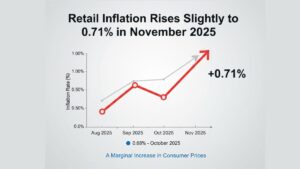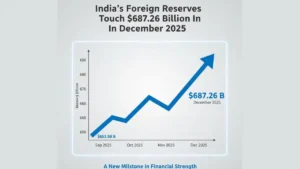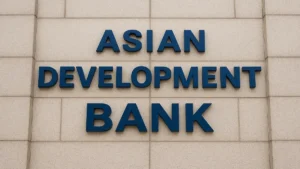India’s economic growth is expected to slow down to 6.4% in 2025, according to a report by Moody’s Analytics. This marks a slight decline from the 6.6% GDP growth in 2024. The report highlights key global factors affecting the slowdown, including new U.S. tariffs and weakening global demand, which are expected to impact India’s exports. The Asia-Pacific region is also witnessing reduced growth, with China’s GDP projected to fall from 5% in 2024 to 4.2% in 2025.
What Are the Key Factors Behind the GDP Slowdown?
Trade Tensions and Export Setbacks
One of the major reasons for India’s GDP slowdown is rising global trade tensions. The introduction of new U.S. tariffs is likely to make Indian exports less competitive, putting pressure on industries reliant on international trade. Additionally, global demand is softening, leading to reduced orders for Indian goods. A weaker export sector directly impacts India’s overall economic growth, as external trade plays a crucial role in driving the country’s GDP.
Impact of Regional Economic Slowdown
Moody’s Analytics notes that the Asia-Pacific region is experiencing a broader economic deceleration, which could indirectly affect India. China’s GDP growth is projected to slow to 4.2% in 2025, down from 5% in 2024. Since China and India are key players in the global market, any slowdown in China’s economy could disrupt supply chains and trade patterns across the region.
Currency and Investment Challenges
India’s weakening rupee, declining foreign investment, and inflation concerns are additional factors contributing to the GDP slowdown. The falling value of the rupee increases import costs, putting pressure on businesses and consumers. Lower foreign direct investment (FDI) may also limit growth in sectors such as manufacturing and technology. Inflation volatility remains a challenge, impacting the purchasing power of consumers.
How Is the Government Addressing the Slowdown?
Fiscal and Monetary Policy Reforms
To maintain a stable economic outlook, Moody’s Analytics emphasizes the need for policy reforms. India must focus on monetary measures to control inflation, strengthen the rupee, and attract foreign investments. Fiscal policies will also need to be adjusted to boost economic resilience.
Budgetary Support for Domestic Growth
The Indian government is expected to prioritize domestic demand in the upcoming Union Budget. This includes investments in infrastructure, employment generation, and economic stimulus measures. A major goal is to reduce the fiscal deficit to below 4.5% of GDP in the next fiscal year.
Encouraging Private Consumption and Investment
Despite the slowdown, India remains one of the fastest-growing economies in the world. Moody’s highlights that private consumption and investment will continue to drive growth. Strong consumer demand in sectors like retail, services, and technology could help sustain momentum.
How Does India’s Growth Compare to the Global Economy?
Global GDP Growth Forecast
The United Nations projects global economic growth at just 2.8% in 2025, reflecting a slowdown across major economies. The U.S. and China are also witnessing lower growth rates, which could have ripple effects on emerging economies like India.
India’s Relative Economic Strength
Despite the projected slowdown, India’s GDP growth at 6.4% in 2025 remains higher than that of many developed nations. The country’s strong domestic market, expanding digital economy, and growing middle class provide a foundation for long-term growth.
What Lies Ahead for India’s Economy?
Recent Growth Trends and Outlook
India recorded a 6.6% GDP growth in 2024, supported by rising rural demand, strong industrial growth, and expansion in services. Looking ahead, maintaining a high growth trajectory will depend on employment generation, skill development, and boosting domestic manufacturing.
Long-Term Growth Potential
Experts believe that India’s long-term economic prospects remain positive, provided the government successfully implements necessary reforms. Policies that enhance labor productivity, attract investments, and support innovation will be crucial in sustaining growth beyond 2025.
India’s GDP Growth to Slow to 6.4% in 2025: Key Highlights
| Key Aspect | Details |
|---|---|
| Why in News? | Moody’s Analytics projects India’s GDP growth to slow to 6.4% in 2025, down from 6.6% in 2024, due to global trade tensions and weakening exports. |
| Projected Growth | 6.4% in 2025 (Moody’s Analytics forecast) |
| Key Reasons for Slowdown | New U.S. tariffs, declining global demand, Asia-Pacific slowdown, weakening rupee, foreign investment concerns, inflation volatility. |
| China’s GDP Forecast | Expected to decline from 5% in 2024 to 4.2% in 2025, impacting regional growth. |
| Global Growth Outlook | The UN forecasts global GDP growth at 2.8% in 2025, with slower growth in major economies like the U.S. and China. |
| Government Response | Union Budget focus on domestic demand, fiscal deficit target below 4.5% of GDP, policy reforms in monetary and trade sectors. |
| Long-Term Outlook | India remains one of the fastest-growing economies, with growth supported by private consumption, investment, and policy measures. |



 Retail Inflation Rises Slightly to 0.71%...
Retail Inflation Rises Slightly to 0.71%...
 India’s Foreign Reserves Touch $687.26 B...
India’s Foreign Reserves Touch $687.26 B...
 ADB Raises India’s Growth Forecast to 7....
ADB Raises India’s Growth Forecast to 7....







